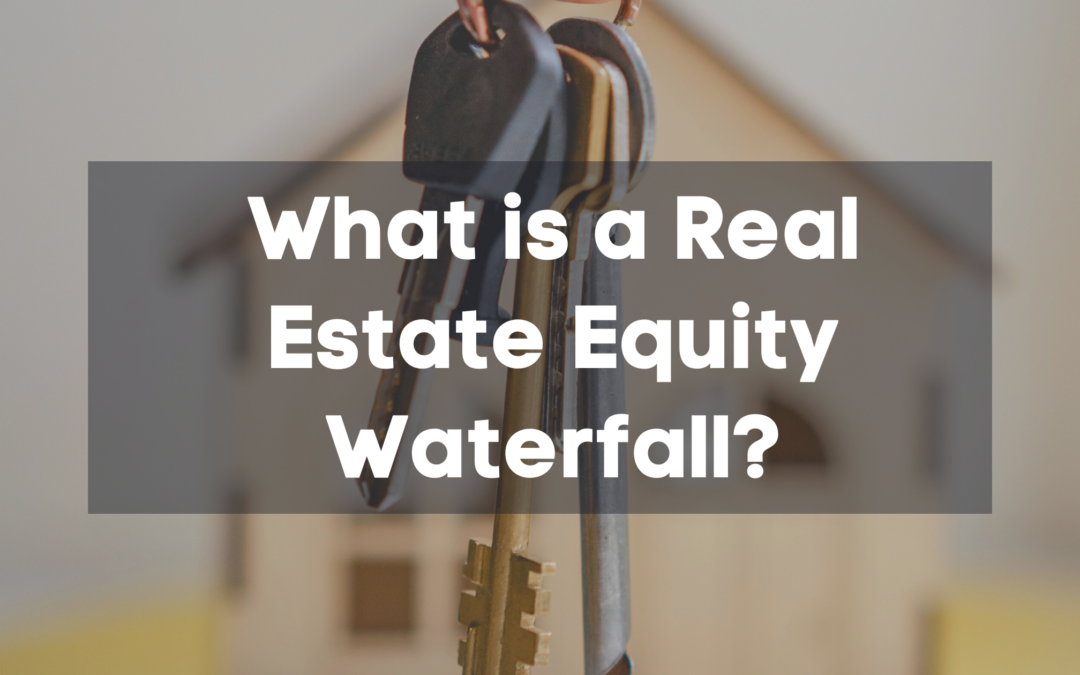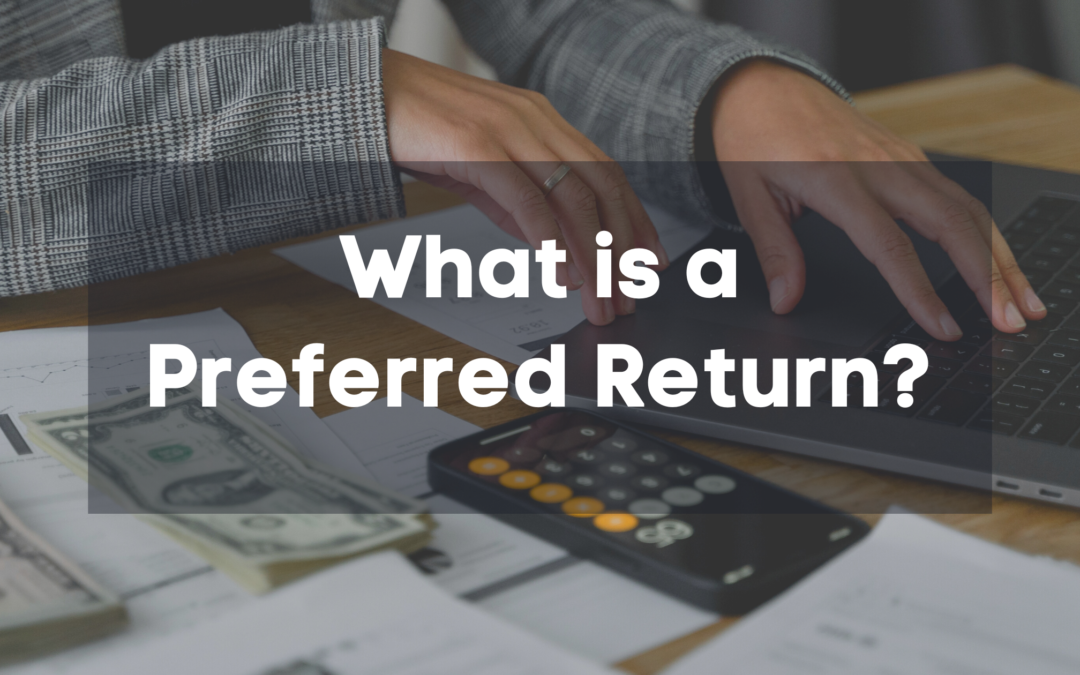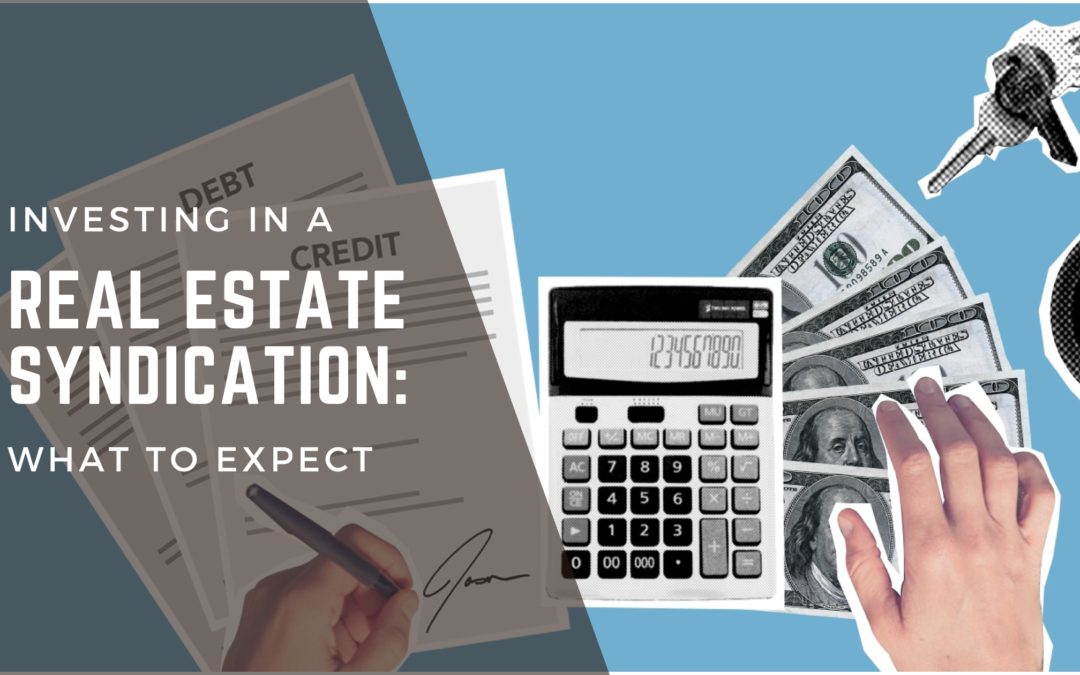
What is Equity Multiple in Commercial Real Estate
Understand what the Equity Multiple is and how to calculate it

Understand what the Equity Multiple is and how to calculate it



A preferred return, also known as a “preferred yield” or “hurdle rate,” is a minimum rate of return guaranteed to a particular class of investors, such as preferred shareholders or passive investors, before other investors, such as general partners, receive any returns on their investments. Now, the term “guaranteed” can be misleading. There is no GUARANTEE in investing; however, this is the amount of return an investor will receive BEFORE the sponsor in the deal receives compensation.
The preferred return, or “pref,” is specified in the investment agreement and package and is often a highlight of the marketing materials. This is used to compensate preferred shareholders for the higher risks they are taking compared to traditional investments, such as stocks or bonds.
What is Equity Multiple in Commercial Real Estate(Opens in a new browser tab)
[divi_switch_layout id=”1311″]
The calculation of a preferred return can vary depending on the terms of the investment agreement. However, in most cases, the preferred return is calculated as a percentage of the invested capital. For example, if an investor invests $100,000 with a preferred return of 8%, they would receive a preferred annual return of $8,000.
Sometimes, the preferred return may be calculated based on the invested capital (capital contribution) plus any accrued interest. For example, if an investment agreement specifies a preferred return of 8% per year, the investor would receive 8% of the invested capital each year. Any unused preferred return would accrue interest for the following year.
It’s important to note that the preferred return is usually paid out on an annual or semi-annual basis and is often subject to a cap or limit, which means that the preferred return may stop accruing once it reaches a certain level.
In a real estate project, the preferred return may be calculated based on the property’s net operating income. In private equity investments, it may be found in the portfolio’s overall performance. Alternative assets or alternative investments can vary, but a preferred return is common.
What is a Real Estate Equity Waterfall?(Opens in a new browser tab)
Preferred return is essential for a few reasons:
In conclusion, preferred return is an essential component of many investments, as it provides investors with a minimum level of return, a priority of returns, a mechanism to align interests, and can increase the attractiveness of the investment to potential investors.
Structuring Debt and Raising Equity: Book Summary(Opens in a new browser tab)
Private equity investments have important terms and jargon that can confuse those unfamiliar with the industry. Here are some standard terms used in private equity investments:
How Multifamily beats Single Family(Opens in a new browser tab)
Preferred return and preferred equity are two different concepts in finance and investments.
Preferred return refers to a minimum rate of return (preferred return hurdle) that an investor is guaranteed to receive on their investment before other investors receive any returns. This rate of return is often specified in the investment agreement and may be calculated as a percentage of the invested capital. Preferred return is often used in private equity and real estate investments to provide investors with a minimum level of certainty (almost a guaranteed payment)
.
Preferred equity, on the other hand, refers to a type of equity security that prioritizes common equity when it comes to receiving dividends or distributions. This refers to private equity firms that provides capital in the second position of the capital stack taking a higher tier position than the Limited Partners and 2nd only to primary debt (bank Loan).
Multi-Family Property Classifications and Your Investment Strategy(Opens in a new browser tab)
An accurate preferred return and a pari passu preferred return are two different types used in private equity and real estate investments.
Pari Passu Preferred Return:
A pari passu preferred return is paid to investors on a pro-rata basis, meaning that all investors receive the same percentage of return distributions on their investment. In a pari passu structure, the pref is paid out to all investors simultaneously, regardless of their investment amounts. In this structure, all investors receive the same percentage of returns, but those with more significant investments will receive a more considerable absolute return.
See the Following Examples below for illustrative purposes:
Simple preferred and cumulative preferred returns are two types of preferred returns used in private equity and real estate investments.
Simple Preferred Return: A simple preferred return is paid out to investors periodically, such as annually or quarterly. In a simple preferred return structure, the preferred return is paid out as long as the investment generates sufficient returns. The expected return will only be paid out if the acquisition generates enough returns to cover the desired return.
Cumulative Preferred Return: A cumulative preferred return that accrues over time and is paid out only when the investment generates sufficient returns to cover the cumulative amount of preferred return that has accrued. In a cumulative preferred return structure, if the investment does not generate enough to cover the cumulative amount of preferred return that has accrued, the preferred return will accumulate and be paid out later when the investment generates sufficient returns.
A lookback provision is a clause in a private equity or commercial real estate investment agreement that allows the investment manager to adjust the preferred return in certain circumstances.
The lookback provision typically allows the investment manager to “look back” at the performance of the investment over a specified period, such as a year or several years. Suppose the investment has performed better than the preferred return. In that case, the investment manager may adjust the preferred return upward to a higher rate to reflect the higher returns generated. On the other hand, if the asset has performed worse than the preferred return, the investment manager may choose to adjust the preferred return downward to a lower rate to reflect the lower returns generated by the investment.
The lookback provision is often included in investment agreements to ensure that the preferred return remains aligned with the actual return generated by the investment. It allows the investment manager to adjust the preferred return to ensure that the investment remains attractive to a potential investor while also allowing the investment manager to share in the benefits of any outperformance of the investment.
In conclusion, a lookback provision is a clause in an investment agreement that gives the investment manager the option to adjust the preferred return based on the performance of the investment over a specified period. This provision ensures that the preferred return remains aligned with the actual returns generated by the asset.
A catch-up provision is a clause in a private equity or real estate investment offering that allows for the payment of accumulated preferred return in the event of good future investment performance.
In a cumulative preferred return structure, if the investment does not generate sufficient returns to cover the cumulative amount of preferred return that has accrued, the preferred return will accumulate and be paid out later when the investment generates sufficient returns. The catch-up provision specifies the conditions under which the accumulated preferred return will be paid out, such as a certain level of investment performance or the sale of the investment.
The catch-up provision assures private equity investors that they will eventually receive their accumulated preferred return, even if the investment generates insufficient returns in the short term. It also allows the investment manager to defer the payment of the accumulated preferred return until the investment is in a better position to generate sufficient returns to cover the cumulative amount of desired return that has accrued.
In conclusion, a catch-up provision is a clause in an investment agreement that allows for the payment of accumulated preferred return in the event of good future investment performance. This provision assures passive real estate investors that they will eventually receive their accumulated preferred return and provides the investment manager with the flexibility to defer the payment of the accumulated preferred return until the investment is in a better position to generate sufficient returns.
This article is for informational purposes only. You should seek investment advice from your attorney and CPA before entering into any agreement.
If you would like to learn more about the various types of real estate investments and syndications we have coming online, please join our investor club to gain access.
As a top-performing sales professional in supply chain/logistics for almost 20 years, Jeff Davis has been putting his commissions to work for him in real estate since 2015 and is now partnered in almost 2000 units across 4 states in the US.

Estimated reading time: 14 minutes
Investing in multifamily syndications offers passive investors a unique opportunity to benefit from real estate investments without the day-to-day responsibilities of property management. In this guide, we’ll delve into the key aspects of real estate syndication deals, from understanding the roles of general partners and limited partners to exploring the communication touchpoints, structures, and potential returns associated with this investment strategy.
Real estate syndication involves a collaborative partnership where a group of investors pools their resources to invest in a single real estate project. This partnership typically comprises general partners (GPs) and limited partners (LPs), each with defined roles based on their capital commitment, effort, and relative liability in the investment.
For passive investors, this structure presents a great way to engage in real estate investments without the need for active participation. Unlike dealing with the intricacies of managing rental properties or navigating the stock market, passive investors can leverage the expertise of a real estate syndicator and their team.
One of the critical elements of a real estate syndication is the business plan, which outlines the investment strategy and expected outcomes. GPs, as deal sponsors, are responsible for developing and executing this plan, ensuring the successful operation and eventual sale of the property.
Before diving into a real estate syndication, due diligence is crucial. Potential investors should thoroughly evaluate the past performance of the deal sponsor, the property management team, and the overall track record of the syndicator. This informed decision-making process helps mitigate potential risks and aligns investors with opportunities that match their investment goals.
Once invested in a real estate syndication, passive investors can expect regular updates and communications. Here’s a breakdown of the typical touchpoints:
What is a K-1? Get the play-by-play of deconstructing a K-1: HERE
These regular updates help investors stay informed about the overall progress and developments throughout the syndication’s lifecycle. The subsequent sections will delve into specific details regarding what investors can expect at each touchpoint, providing a comprehensive understanding of their passive involvement in the real estate syndication.
[divi_switch_layout id=”1311″]
In the realm of real estate syndication, structures play a pivotal role in defining the relationships and responsibilities among the various parties involved. Passive investors participate in a distinct legal entity known as a “special purpose vehicle” (SPV), which facilitates fractional investment and shields them from the majority of risks associated with the investment.
While several legal structures are viable, limited liability company (LLC) formations are the most common way to structure a real estate syndication. However, the choice of organization isn’t a requirement mandated by the Securities and Exchange Commission (SEC), allowing flexibility in structuring syndication deals.
When investors engage in real estate syndication through crowdfunding platforms like Bridgestone Capital, the managing entity is typically on the same platform, streamlining communication and collaboration among members.
Understanding these structures is essential for potential investors as it sets the framework for their involvement in the real estate syndication. In the subsequent sections, we’ll explore the practical aspects of how to invest in a real estate syndication and the types of syndications prevalent in the real estate market.
By following these steps, individual investors can navigate the process of investing in a real estate syndication, tapping into the potential returns and benefits offered by this passive investment strategy. In the upcoming sections, we’ll delve into the specific types of syndications in real estate and the associated benefits and disadvantages of this investment approach.
Each type of syndication presents unique benefits and considerations. Passive investors should align their investment strategy with the specific dynamics of the syndication type that best suits their financial goals. As we delve into the advantages and disadvantages of real estate syndication in the following sections, a closer look at these syndication types will provide clarity for making well-informed investment decisions.
Real estate syndication is a dynamic investment strategy that offers an array of benefits to savvy investors looking to diversify their portfolios. Understanding these advantages can help potential investors make informed decisions in the world of real estate syndication.
A. Tax Benefits and Deductible Mortgage Interest: Real estate syndication presents investors with unique tax advantages, including the ability to deduct mortgage interest. As participants in a syndication deal, investors may benefit from tax deductions associated with the property, contributing to potential overall tax efficiency. This becomes particularly valuable as investors seek ways to optimize their financial positions through strategic tax planning.
B. Lower Minimum Investments and Diversification: One of the most appealing aspects of real estate syndication is its accessibility. Investors can enter the real estate market with lower minimum investments compared to solo property ownership. This lower barrier to entry allows for broader participation, and investors can diversify their portfolios by engaging in multiple syndication projects. Diversification across various markets, property types, and risk profiles helps mitigate potential risks and enhances the overall resilience of the investment portfolio.
C. Passive Investing and Reduced Liability for Individual Investors: Real estate syndication provides a unique avenue for passive investing in the real estate market. Unlike direct ownership of rental properties, syndication allows individual investors to benefit from real estate income without the day-to-day responsibilities of property management. Additionally, participants assume reduced liability as they invest through a limited liability entity, shielding them from the majority of risks associated with the project. This passive approach empowers investors to enjoy the benefits of real estate ownership without the burdensome tasks typically associated with property management.
In summary, real estate syndication offers a trifecta of advantages—tax benefits, lower entry barriers, and passive investing with reduced liability. These benefits make real estate syndication an attractive investment opportunity for those seeking to capitalize on the potential of the real estate market while minimizing the hands-on involvement traditionally associated with property ownership.
While real estate syndication comes with numerous benefits, it’s essential for potential investors to be aware of the potential drawbacks. Understanding these disadvantages helps individuals make informed decisions and navigate the complexities of syndicated real estate investments.
A. Sponsors’ Potential Profits:One notable disadvantage is that sponsors or general partners in a real estate syndication can potentially make profits even if individual investors do not. Sponsors often earn acquisition and asset management fees, irrespective of the project’s performance. While these fees incentivize sponsors to drive positive results, investors should carefully review the terms of these fees and negotiate effectively to align the sponsor’s success with that of the investors.
B. Loss of Control for Individual Investors:Investing in a real estate syndication means relinquishing a significant degree of control over the asset. Unlike direct ownership where investors can actively manage their properties, syndication involves a more passive role for individual investors. While this passive approach is appealing to those seeking a hands-off investment, it does mean that decision-making authority rests largely with the sponsors and managing entities. Investors should be comfortable with this trade-off and conduct thorough due diligence on the sponsor team’s track record and decision-making processes.
C. Relatively Illiquid Nature of Syndication Investments:Real estate syndication investments are inherently relatively illiquid. Unlike stocks that can be bought or sold on the open market, syndicated real estate investments typically involve a longer hold period. Investors should be prepared for their capital to be tied up for the duration of the investment, which may range from several years to a decade. This lack of liquidity can impact an investor’s ability to quickly access funds, making it crucial to align investment horizons with individual financial goals.
A. Projected Returns for LP Investors in Debt and Equity Syndications: Investors engaging in real estate syndication can anticipate returns that vary based on the type of syndication—debt or equity. For debt syndications, where investors participate by lending funds for real estate projects, an annual rate of return target typically falls within the range of 8-12%. This return is influenced by the fixed rates of return associated with short-term commercial loans.
On the other hand, equity syndications, involving ownership of a portion of the property, offer the potential for more substantial returns. LP investors in equity syndications may target a total return, measured as Internal Rate of Return (IRR), of 15% or more. The actual return value depends on the specific terms outlined in the real estate syndication agreement, including profit-sharing protocols and the sponsor’s performance.
B. Considerations for Commercial Real Estate Investments: Commercial real estate syndications often yield larger returns due to the scale and complexity of such projects. Investments in office buildings, apartment complexes, or other commercial properties can provide attractive returns to investors. The Capitalization Rate (Cap Rate), a metric measuring the property’s annual net operating income relative to its purchase price, is a key indicator of potential returns in commercial real estate syndication.
Investors should carefully assess the projected returns outlined in the investment summary and take a closer look at the property’s historical performance, occupancy rates, and future potential for appreciation. Evaluating the market conditions and the sponsor’s ability to execute the business plan becomes crucial for making well-informed investment decisions.
Real estate syndication offers attractive opportunities, but investors need to exercise due diligence and be aware of potential pitfalls. Here are key considerations to safeguard your investment:
A. Importance of Due Diligence:Before committing to a real estate syndication, thorough due diligence is paramount. Evaluate the sponsor’s track record, past performance on similar projects, and the expertise of the property management team. Scrutinize the market conditions and economic factors affecting the specific deal. This comprehensive assessment helps investors make informed decisions and mitigate risks associated with the investment.
B. Evaluating Platform Track Record and Individual Sponsors:For those engaging through online platforms, assessing the track record of both the platform and individual sponsors is crucial. Platforms like EquityMultiple provide transparency into past performances, allowing potential investors to make well-informed choices. Understanding how the platform selects and vets sponsors, as well as their commitment to ongoing asset management, contributes to a more informed investment experience.
C. Understanding Contractual Obligations and Liquidity: Investors should carefully review legal documents and understand the contractual obligations associated with the syndication. This includes the hold time, which indicates how long the capital will be tied up, and the terms of potential exit strategies. Additionally, gaining clarity on liquidity provisions and knowing when distributions can be expected enhances transparency and aids in aligning the investment with individual financial goals.
A. Risks Associated with Real Estate Syndication:While real estate syndication presents lucrative opportunities, it is essential for investors to recognize associated risks. Market risk, operational challenges, legal complexities, and potential liquidity issues are inherent to real estate investments. Understanding and assessing these risks allows investors to make informed decisions aligned with their risk tolerance and investment goals.
B. Determining Potential Returns and Differences from REITs: Investors often compare real estate syndication with Real Estate Investment Trusts (REITs). While both involve real estate, they differ in ownership, management, liquidity, and regulation. Real estate syndication provides direct ownership in specific properties, allowing investors to actively participate in decision-making. In contrast, REITs involve shares in a portfolio of properties managed by a company. Recognizing these distinctions helps investors choose the investment vehicle that aligns with their preferences and financial objectives.
C. Bottom Line and Key Considerations for Investors: In the realm of real estate syndication, a bottom line emerges — informed decision-making is paramount. Investors should conduct thorough due diligence, leverage available resources like private placement memorandums and financial statements, and seek clarity on any uncertainties. Recognizing the illiquid nature of real estate syndications, investors should align their investment horizon with the hold period outlined in the deal. By understanding the intricacies and asking pertinent questions, investors can navigate the landscape with confidence.